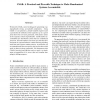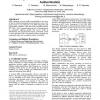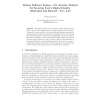123 search results - page 15 / 25 » Obfuscation for Cryptographic Purposes |
NDSS
2009
IEEE
14 years 2 months ago
2009
IEEE
We describe CSAR, a novel technique for generating cryptographically strong, accountable randomness. Using CSAR, we can generate a pseudo-random sequence and a proof that the elem...
GLVLSI
2007
IEEE
14 years 1 months ago
2007
IEEE
RFID technology increases rapidly its applicability in new areas of interest without guaranteeing security and privacy issues. This paper presents a new architecture of an RFID tr...
ICCCN
2007
IEEE
14 years 1 months ago
2007
IEEE
— Assuring cryptographic integrity of mutable fields in any on-demand ad hoc routing protocol is more challenging than that of non mutable fields. We propose an efficient auth...
ACISP
2003
Springer
14 years 26 days ago
2003
Springer
Abstract. This paper presents a robust software token that was developed to protect user’s digital identity by simple software-only techniques. This work is closely related to Ho...
ACNS
2010
Springer
14 years 13 days ago
2010
Springer
Most side-channel attacks that have been published in the open literature assume known- or chosen-message adversarial scenarios. In this paper, we analyze the increase of the attac...



